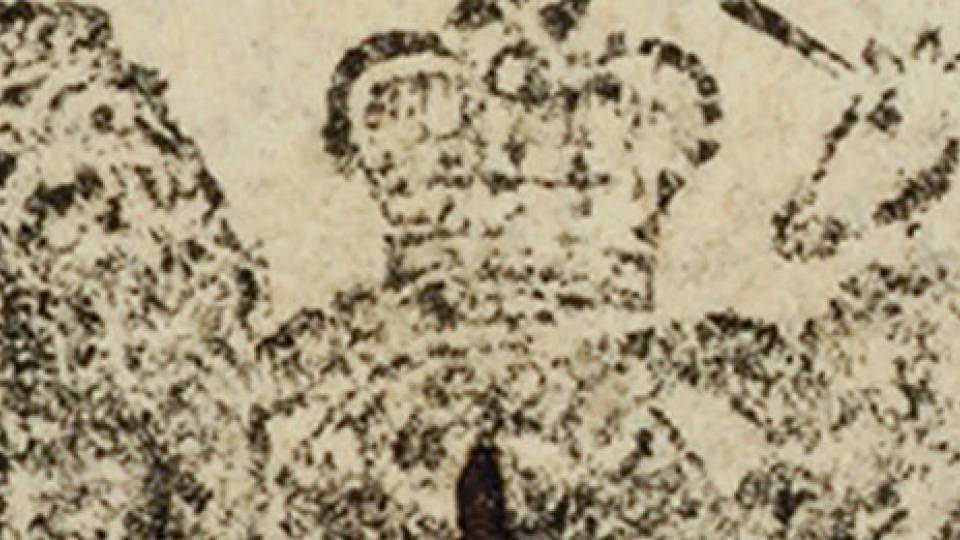Paper money will become works of art in the Princeton University Library(Link is external) exhibit “Money on Paper: Bank Notes and Related Graphic Arts from the Collections of Vsevolod Onyshkevych and Princeton University,” starting Monday, Aug. 30. Currency from the University’s Numismatic Collection(Link is external) will be on view in the Leonard Milberg Gallery for the Graphic Arts at Firestone Library on the Princeton campus.
The exhibit, which runs through Jan. 2, 2011, is free and open to the public. A lecture by paper money expert Mark Tomasko on “The Art of Bank Note Engraving” also will be held at 3 p.m. Sunday, Oct. 17, in McCormick Hall, Room 101 on the University campus. The free lecture will be followed by a reception in Firestone Library and a curatorial tour of the exhibit.
“Paper money as a form of art might seem the makings of a rather small exhibit, to judge from the modern bills of the United States and Europe. Bank notes, however, have constituted one of the dominant forms of visual communication for the past two centuries, and in many cases can be seen as works of art in their own right,” Princeton Curator of Numismatics Alan Stahl said.
[**Media interested in more information about the exhibit, or who are interested in digital images from the collection, may contact Stahl at astahl@princeton.edu or (609) 258-9127.]
One of the highlights of the exhibit will be the first public display of the recently discovered banknote engraving of a grouse by John James Audubon, the great wildlife illustrator’s first published work. On display with a sample sheet containing the vignette will be an original watercolor by Audubon, a steel printing plate from “The Birds of America,” and the Princeton first edition of the elephant folio book open to the page with Audubon’s drawing of the pinnated grouse.
Because British Colonial policies resulted in a dearth of circulating coins, the American Colonies were the home of the earliest regular issues of paper money. Illustration was applied to Colonial currency as an anti-counterfeiting device as well as for aesthetic purposes. The most inventive printer of paper money of the time was Benjamin Franklin, who devised a system of transferring the vein patterns of tree leaves to printing plates to foil counterfeiters. The Princeton exhibit includes a large selection of Franklin’s nature-print notes, as well as issues of Paul Revere and the South Carolina engraver Thomas Coram, who brought classical imagery to that Colony’s bank notes.
The great American painter Asher B. Durand also was a major figure in the development of bank note art in America. Along with his brother Cyrus, who invented a highly decorative series of anti-counterfeiting devices, he developed a classical, patriotic approach to bank note design that dominated the medium for the first half of the 19th century.
A section of the Princeton exhibit will explore the divergence of imagery on the bank notes of northern and southern issuers before and during the Civil War. Collectors of paper money will be especially interested by the complete set of six notes printed by the National Bank Note Company in New York and smuggled into the Confederacy in 1861 for distribution as notes of Montgomery, Ala., and Richmond, Va. The American section of the exhibit ends with the high point of American bank note art, the Educational Series of 1896, designed and engraved by some of the most important illustrators of the day.
The stagnation of American paper money design in the 20th and 21st centuries is put into relief by comparison with some of the beautiful and creative examples of European notes, on loan for the exhibit from the collection of Vsevolod Onyshkevych, a graduate of the Princeton class of 1983. Alfons Mucha, the popular creator of poster art, designed paper money for Czechoslovakia in the 1920s that epitomizes the glory of art nouveau design. Other important artists of the period, such as Emile Vloors in Belgium and Eliel Saarinen in Finland, put their stamp on the currency of the period.
In the second half of the 20th century, R. D. E. Oxenaar and J. T. G. Drupsteen created a distinctive look for the bank notes of the Netherlands. In the era since the euro was adopted as currency throughout many European countries, Switzerland has kept the innovative look of its paper money with the computer-enhanced colorful notes designed by Jörg Zintzmeyer, while the Faroe Islands have issued a series of simple, evocative notes based on the watercolors of Zacharias Heinesen.
Hours for the Milberg Gallery are 9 a.m. to 5 p.m. Monday through Friday, noon to 5 p.m. Saturday and Sunday, and closed holidays. Curatorial tours of the exhibit will be held at 3 p.m. Sunday, Nov. 22, and Sunday, Dec. 12.
Further information about the exhibit may be obtained by contacting Stahl at astahl@princeton.edu or (609) 258-9127.
A publication titled “Money on Paper” by Stahl accompanies the exhibit. It contains a full catalogue of the bank notes on display with color photographs of many of them. There are three additional illustrated essays in the catalogue: Mark Tomasko writing on “Bank Note Engraving in the United States,” Francis Musella on “Benjamin Franklin’s Nature Printing on Bank Notes,” and an edited version of the article by Robert Peck and Eric Newman entitled “Discovered! The First Engraving of an Audubon Bird.” The book is available for $40 from the Friends of Princeton University Library, 1 Washington Road, Princeton, NJ 08544. Inquiries about ordering can made to Linda Oliveira at loliveir@princeton.edu or at (609) 258-3155.




